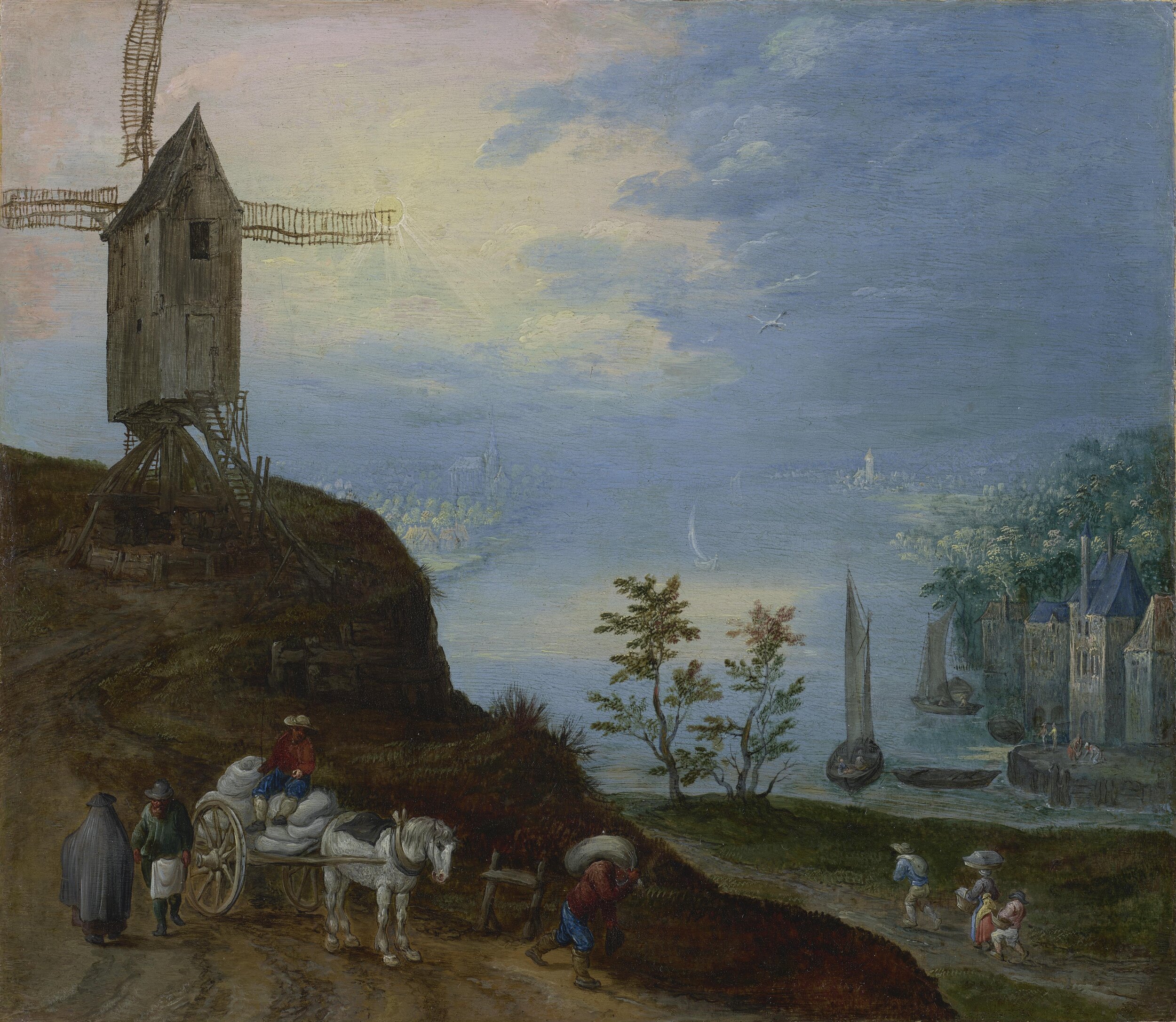ADRIAEN VAN STALBEMT (Antwerp 1580 – Antwerp 1662)
A Windmill on a Hill Overlooking a Harbor
oil on copper laid down on panel
7.7 x 8.7 inches (19.5 x 22 cm.)
PROVENANCE
Anonymous sale, Christie’s, London, December 9, 2005, lot 102 (as Circle of Jan Brueghel I)
Galerie Florence de Voldére, Paris, by September 2006, (as attributed to Jan Brueghel the Younger) from whom acquired by
Private Collection, Washington, D.C., September 2006 until the present time
Dr. Klaus Ertz, author of the catalogue raisonné on Adriaen van Stalbemt, has viewed this work in the original and issued a certificate of authenticity dated Lingen, April 30, 2021. He refers to this painting as a “gem” of excellent quality, and its state as exceptionally good. He further notes the influence of Jan Brueghel the Elder in the composition. For Dr. Ertz the high vantage point and the traditional separation of the landscape into three distinct sections of foreground, middle and background, mark its execution as from the start of Stalbemt’s career circa 1605 – 1610 in Antwerp. The distinct rectangular upright houses that flank the harbor’s right bank are unique to the painter, and act as a stylistic signature.
After the fall of Antwerp to the Spanish in 1585, Adriaen van Stalbemt’s family moved to Middelburg as they were Protestant. In all likelihood this is where he received his training. By 1609 he had returned to Antwerp, probably after the signing of the Twelve Years’ Truce which ended hostilities between Spain and the Northern Netherlands. The same year he became a Master of the Guild of St. Luke, Antwerp, and its Dean from 1618 – 1619. He trained three apprentices: Hans Mesmaeckers, Joannes Mesmakers, and Johannes de Vargas. His wife was Barbara Verdelft the daughter of Jan Verdelft I, an art dealer. At the request of King Charles I, Stalbemt worked in England from 1633 – 1634. One work done during this period in collaboration with Jan Belcamp of A View of Greenwich with Charles I and Henrietta Maria with a Group of Courtiers is in the Royal Collection. Now best known for his landscapes, he also painted religious, mythological, and allegorical works as well as executed prints. He further contributed staffage to a number of contemporaries including Jan Brueghel the Elder, Pieter Brueghel the Younger, Frans Francken II, Pieter Neefs the Elder, and Hendrick van Steenwyck the Younger. His work reflects a variety of influences from Herri Met de Bles, Adam Elsheimer, Gillis van Coninxloo, Paul Bril, Hendrick van Balen and most particularly as illustrated by this copper panel Jan Brueghel the Elder.[1]
Works by Stalbemt formed part of the permanent collections of museums in Amsterdam, Antwerp, Berlin, Budapest, Chambéry, Dijon, Dresden, Florence, Frankfurt, Kassel, Madrid, Mainz, Schwerin, and Vaduz among others.[2]
A rutted dirt road invites the viewer into the composition which presents a choice of two divergent paths to follow. That of the midground has a family loaded down with baskets and bundles making their way towards a harbor in the background, a vast blue panorama of coast and sky under a heavenly sun emanating divine rays. It is “a tantalizing glimpse of the great world beyond” and “seemingly infinite expanse of earth, water and sky”.[3] The path in the foreground curves upwards to a spectacularly rickety windmill atop a small hill. In the foreground a horse drawn cart laden with flour sacks has halted. A peasant, with his sack slung over his shoulder, walks down the road. The driver of the cart sits on top of its load, while the miller converses with a woman wearing a huik and black straw hat. It is a view that simultaneously encompasses the terrestrial and celestial by which means Stalbemt pays tribute to the glory of the world and its creator.
[1] Biographical information taken from Jan de Maere et al., Illustrated Dictionary of 17th Century Flemish Painters, volume 2, Brussels, 1994, p. 1112; Jeremy Howarth, The Steenwyck Family as Masters of Perspective, Pictura Nova XII, Brepols, Turnhout, Belgium, 2009, p. 27; Hans Devisscher, “Adriaen van Stalbemt”, Grove Art Online, Oxford Art Online, Oxford University Press, 2016; and “Adriaen van Stalbemt” on rkd.nl (RKD Explore) website.
[2] Jan de Maere, op.cit., volume 2, p. 1112.
[3] Walter S. Gibson, Mirror of the Earth; The World Landscape in Sixteenth – Century Flemish Painting, Princeton University Press, Princeton, N.J., 1989, pp. xxi, 8.
